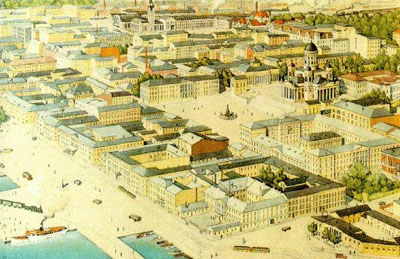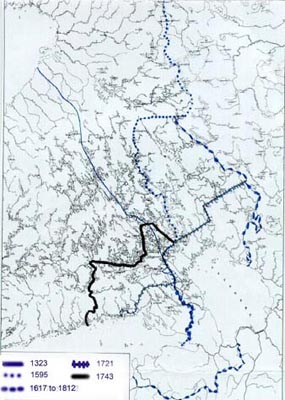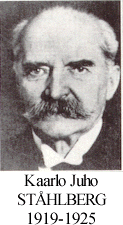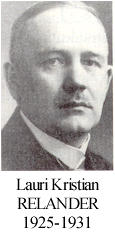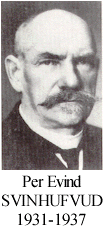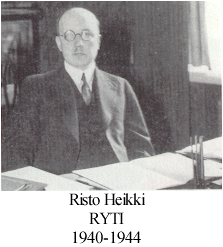Finland
 Flag of Finland | |
| Capital | Capital |
| Inhabitants | 5.326.314 |
| Language(s) | Finnish, Swedish |
Finland is a country in northern Europe famous for its scenic beauty. Thousands of lovely lakes dot Finland's landscape, and thick forests cover almost two-thirds of the land.
The country has a long, deeply indented coast, marked by colorful red and grey granite rocks. Thousands of scenic islands lie offshore.
Ruled by Sweden from the 12th to the 19th centuries and by Russia from 1809, Finland finally won its independence in 1917. During World War II, it was able to successfully defend its freedom and fend off invasions by the Soviet Union and Germany.
In the subsequent half century, the Finns have made a remarkable transformation from a farm/forest economy to a diversified modern industrial economy; per capita income is now on par with Western Europe.
As a member of the European Union, Finland was the only Nordic state to join the euro system at its initiation in January 1999.
Contents |
History
In the 16th century Sweden tried to gain the control of the trade in the Baltic sea district. Therefore, in addition to the cities of Turku, Viipuri and Porvoo, Helsinki and Tammisaari were founded on the southern coast of Finland.
Finland took part in many wars along with Sweden against Denmark, Russia and Poland. Soldiers were accomodated in peasant houses, encampments. When soldiers looted food from houses, in 1596, the peasants rose in a rebellion against the governor of Finland, Klaus Fleming, his soldiers, Finnish Nobility and tax collectors. Finally the peasants were defeated in this so called "peasants' rebellion" named after clubs and maces they used as weapons. About 3000 peasants died in the war.
In the beginning of the new era Finland exported fur and tar. Tar became the most important export product, because it was needed for the surfaces of ships. There wasn't much industry during the Swedish regime.
People lived in class society, but there were a lot of those, too, who didn't belong to any Estate. Those outside the Estates didn't have the opportunity to deal with the affairs of the country in the Diet. The King called in the Diet when he wanted and he was the only one who could make a motion there. The present Parlament is the equivalent of the former Diet.
In 1630's a Swedish member of the Nobility, Pietari Brahe, became the governor of Finland. He succeeded in making many renovations , e.g. he founded four coastal towns and the first inland towns in Finland. He paid attention in the brists of schools and tried to make them better. Thanks to Pietari Brahe Turku got its own Academy in 1640. During the administration of Pietari Brahe the living conditions got a lot better in Finland.
During the years from 1714 to 1721 Finland was occupied by Russians. This time is called Period of Great Hate. In the peace treaty made in Uusikaupunki Finland lost some territory to Russia. As a result of the lost war in 1730's there were born two parties with different opinions, the Hats and the Bonnets. The Bonnets wanted good connections with Russia, but the Hats tried to make friends with the enemies of Russia. The situation became bad in 1771 when Sweden declared so called "The war of Hats" against Russia. Sweden lost the war however and had to give Russia some more territory of Finland in the peace treaty made in Turku. In Tilsit in 1807 the French Emperor Napoleon I and the Emperor of Russia, Alexander I made a pact that Russia would press Sweden to join a commercial blocade against England. The situation led into a war between Sweden and Russia (1808-1809) which is called "The Finnish War" Russia occupied Finland again and in the peace treaty made in Hamina Finland was incorporated into Russia.
Already before the peace the Emperor of Russia Alexander I called in the Finnish Diet in Porvoo in March 1809.
The first Finns
First people who inhabited the area now called Finland were hunters and fishermen. Around 1500 BC people began gradually to use bronze. At the same time in the western Finland and in the inland people started to grow corn. People began to consider the land as theirs and abodes became permanent and of better quality. Around 500 BC agriculture became the principal industry. Finns exchanged furs and fish for salt, weapons, jewellery and fabric with foreigners.
The bodies of the dead were burnt and the ashes were spread on a hill and the belongings of the dead were placed in a tomb which was covered with stones. About 3000 of these so called piles of glacial boulders have been found in Finland.
Between 1155 and 1293 three crusades took place to Finland, western Finland, Hδme and Karelia. As a result Sweden and Novgorod concluded peace in Pδhkinδsaari in 1323 and Finland got its first border. This way most Finns were left within the pale of the Roman Catholic church and Finland was made a part of Sweden. Christianity was settled and the Bishop of Turku acted as a spiritual leader and sometimes also as a temporal leader. During this time the four Estates: the Nobility, the Clergy, the Burgesses and the Peasants were born.
In the Middle Ages the northern countries were united into Kalmari Union which caused many conflicts, until so called "Sweden-Finland" was taken apart from the Union under the leadership of Kustaa Vaasa, who was elected the King of Sweden in 1523. Under the era of Kustaa Vaasa a Lutheran reformation took place in Finland. It was caused by Mikael Agricola, former student of Martin Luther. He created Finnish literary language and published the first Finnish speller, ABC book. He also translated The New Testament into Finnish.
People practised agriculture a lot and in the 18th century proceeded from strip reparceling to general reparceling
Becoming independent
In the late 19th century Russians were not pleased with the special position of Finland. To fulfill the Russification a Russian called N. I. Bobrikov was nominated in 1898 the governor of Finland. His goal was to unite monetary and customs intitutions, to take Russian language into use in every Finnish governmental institution and also to open the Russians a chance of holding posts in Finland. Finns wanted to appeal directly to the Emperor himself so that he should put an end to the program. In a week 523 000 Finns had signed the appeal and a delegation of 500 people left for St Petersburg to take this appeal, "The Great Petition", to the Emperor. The Emperor didn't accept them.
Governor Bobrikov was considered the main responsible for oppression, so in 1904 an official of Senate Eugen Schauman shot him. After the murder he shot himself believing he could make up for the crime with his life.
When in 1905 there began a general strike in Russia in 1905, also all Finns started striking to restore the autonomy. To end the strike the Emperor gave a declaration according to which autonomy was restored in Finland and Russification measures ended. One result was also that the Diet was given up and replaced with Parliament. All 24-year-old citizens got the right to vote, women as well as men, and all were equal. Finnish women were the first in Europe to get the right to vote and so in 1907, when the Parliament gathered for the first session, there were also 19 women among the representatives.
The oppression went on, however, and so during World War I some young men got the idea that Finland should become independent. Some men left Finland for Germany to get military education; they were called jaegers.
The revolutions in Russia in 1917 offered a chance of becoming independent. After the October revolution the Finnish Parliament took superior power to itself and put up a government, the object of which was to make the country independent.
The government gave The Declaration of Independence on 6 December 1917, the day which is now celebrated as the Independence day.
After becoming independent it was discussed in Finland, if there should be a king or a president ruling in Finland. At first Finland was going to become a kingdom, but a German, Friedrich Karl, who was planned to become the king, refused to take the position, because the Germans lost World War I.
Time of independence
In 1919 Kaarlo Juho Ståhlberg was elected the first president of Finland. During his era of administration Finland and Sweden started to argue about Åland. The case was taken to League of Nations, which considered that Åland is a part of Finland.
Lauri Relander became president in the 1925 elections. He travelled a lot and therefore got a nickname "Reissu-Lasse".(Larry the traveller). During the administration of Relander, in the late 1920's the extreme conservative movement grew stronger and joined Lapua movement. Lapua movement was dissolved in the middle of 1930's, because it endangered democracy.
The president at the time, P.E. Svinhufvud pushed forward the dissolving. In August 1939 Germany and the Soviet Union made a nonaggression pact. It said that Finland belongs to front circle of the Soviet Union. In the beginning of autumn 1939 the Soviet Union started claiming territory of Finland, but Finland didn't agree and so the Soviet Union attact Finland on 30 November 1939. Finns fought bravely and gained many victories, but couldn't resist the great attack of the Soviet Union on the Karelian Isthmus in 1940, in which over a milloin Russians took part. So in truce on 13 March 1940 in Moscow Finland lost the Karelian Isthmus, the territory of Lake Ladoga, a part of Salla-Kuusamo region and some smaller areas.
Finns wanted to take back the lost land and believed that Germany would help in fulfilling this dream. On 22 June 1941 Germany declared that Finland was fighting along with it against the Soviet Union. Finland prepared for continued war better than for winter war and occupied quickly the lost land. The attack ended in the late 1941 and stabilized war began. It ended in June 1944. After the Normandy descent began a great attack of the the Soviet Union troops on the Karelian Isthmus. Finland had to give up and agree to make peace. In truce on 19 September Finland had to give back the land it had occupied and in addition to them, Petsamo area. To get peace president Risto Ryti had to resign and he was replaced with Carl Gustav Emil Mannerheim. Finland had also to pay considerable amount of war indemnity. In the late 1940's and in the early 1950's Finns had a period of crisis, because the war indemnity had to be paid and inhabitants from the lost land had to be settled in.
In 1946 J.K. Paasikivi was elected the president. He started creating connections with the Soviet Union. In 1948 Finland and the Soviet Union made YYA-pact, according to which Finland should protect its territory, if somebody tried to attack the Soviet Union through Finland. In 1955 the Soviet Union gave Finland back Porkkala naval base to show friendship. Relations were becoming warmer. The same year Finland was accepted as a member of UN. Soon after that Finland joined also the Council of Nordic countries, which pushed forward cooperation between northern countries; e.g. free travelling without passports.
Further the relations were pushed forward by Urho Kaleva Kekkonen, who was elected president in 1956. He has acted as president for the longest time of all, because he was so popular as well in Finland and in foreign countries. In 1961 Finland became an outer member of EFTA. Kekkonen deserves credit for Finland being the host country of ETY-conference in 1975.
In 1982 Mauno Koivisto was elected president after Kekkonen had resigned for health reasons. After a year YYA-pact was prolonged until 2003, but it was called off after the Soviet Union had broken down.
Urho Kekkonen died in 1986. In the late 1980's Finland began to get closer to Europe. It joined many organizations, among others EN and in 1995 EU.
In 1994 Martti Ahtisaari was elected president. Now Finland is planning to join EMU and some people have talked about joining the NATO.
Culture
Finnish humour often ties in the locals' love of a tipple with their legendary reticence to make small talk. This is demonstrated in the joke below, which features the stoic Finnish heroes, Pekka and Toivonen.
- One day Pekka and Toivonen meet after a long time apart and they go to a sauna in the woods. They drink vodka for a couple of hours. Pekka asks how Toivonen has been doing. Toivonen says nothing, but continues drinking for a couple of hours. Then, slowly, he replies: "Did we come here to babble, or did we come here to drink?"
Arts
Tove Jansson, the author of the Moominland stories, probably has the highest international profile among contemporary Finns, although you cannot escape the design work of Alvar Aalto in public buildings, towns and furniture. Jean Sibelius, one of the greatest of modern composers, wrote recognisably Finnish pieces for the glorification of his people and in defiance of the Russian oppressors. Sibelius and the nationalistic painter Akseli Gallen-Kallela fell under the spell of Karelianism, a movement going back to the folk songs Elias Lonnrot compiled for the national epic, the Kalevala in the 1830s. The Kalevala is an epic mythology that includes creation stories and the fight between good and evil. Aleksis Kivi founded modern Finnish literature with Seven Brothers, a story of brothers who try to escape education and civilisation in favour of the forest.
Language
Finnish is a Uralic language and belongs to the Finno-Ugric group. It is closely related to Estonian and Karelian, and has common origins with Samoyed and the languages spoken in the Volga basin. The most widely spoken of the Finno-Ugric languages is Hungarian, but similarities with Finnish are few. With 6% of the population speaking Swedish, Finland is officially a bilingual country. Finlandssvenska, or 'Finland's Swedish', is very similar to the language spoken in Sweden, but local dialects have many Finnish words.
Food & Drinks
Finnish food has elements of both Swedish and Russian cuisines, but with a lot of variations and local specialities. Potato is the staple food, served with various fish or meat sauces. Some traditional meals include game: try snow grouse, reindeer stew, glowfired salmon or raw pickled salmon. Strong beers, wines and spirits are sold in licensed bars and restaurants and by the state network, aptly named Alko. Coupled with strict import restrictions, this makes alcohol prices prohibitively high and merry-making a serious business.
Events
coming soon...
National holidays
- Jan 1: New Year's Day
- Feb 24: Independence Day
- May 1: Spring Day
- Jun 23: Victory Day, Midsummer's Eve
- Jun 24: St John's Day (Summer solstice)
- Aug 20: Restoration of Independence
- Dec 25: Christmas Day
- Dec 26: 2nd Day of Christmas
- Good Friday
- Easter Sunday
- Whit Sunday (Pentecost)
Embassies
- Embassy of Argentina in Finland
- Austrian Trade Commission in Helsinki, Finland
- Canadian Embassy in Helsinki, Finland
- Embassy of Colombia in Helsinki, Finland
- Costa Rica Embassy in Scandinavia
- Embassy of Croatia in Helsinki, Finland
- Embassy of Cyprus in Helsinki, Finland
- Royal Danish Embassy in Helsinki, Finland
- Embassy of Estonia in Helsinki, Finland
- French Embassy in Helsinki, Finland
- German Embassy in Helsinki, Finland
- Embassy of the United Kingdom of Great Britain in Helsinki, Finland
- Embassy of the Greece in Helsinki, Finland
- Embassy of the Hungary in Helsinki, Finland
- Embassy of the Iceland in Helsinki, Finland
- Embassy of Indonesia in Helsinki, Finland
- Embassy of the Italy in Helsinki, Finland
- Italian Culture Institute in Helsinki, Finland
- Embassy of Japan in Helsinki, Finland
- Royal Netherlands Embassy in Helsinki, Finland
- Palestinian General Delegation to Finland
- Embassy of Peru in Helsinki, Finland
- Embassy of Portugal in Helsinki, Finland
- U.S. Embassy in Helsinki, Finland
- Australian Consulate in Helsinki, Finland -- Museokatu 25B, FIN-00100, Helsinki, Finland Tel: 447233 Fax: 440916 E-mail: stephen.kemppainen@auscon.inet.fi
- Embassy of Belgium in Helsinki, Finland -- Kalliolinnantie 5, 00140 Helsinki Tel: 17.04.12 Fax: 62.88.42 E-mail: Helsinki@diplobel.org
- Canadian Embassy in Helsinki, Finland -- P. Esplanadi 25B, 00101 Helsinki (P. O. Box 779, 00101 Helsinki) Tel: 171141 Fax: 601060 E-mail: hsnki@paris03.x400.gc.ca
- Royal Danish Embassy in Helsinki, Finland -- Centralgatan 1, FIN-00100 Helsingfors, Finland. Tel: 358 9 6841050 Fax: 358 9 68410540 E-mail: danmark@kolumbus.fi
- Embassy of France in Helsinki, Finland -- Itanen Puistotie 13 B.P. 762 - 00140 Helsinki Tel: 618 780 Fax: 618 78 342
- Embassy of Japan in Helsinki, Finland -- Etelaranta 8 00130, Helsinki, Finland. Tel: 633011 Fax: 633012
- Consulate General of Singapore in Helsinki, Finland -- Senterikuja 2, Helsinki, Finland (P O Box 5, SIN - 004411) Tel: 5039280 Fax: 5039191
- Taipei Economic and Cultural Office in Helsinki, Finland -- Aleksanterinkatu 17, 4th Floor 00100, Helsinki, Finland Tel: 69692420 Fax: 69692421
- British Embassy in Helsinki, Finland -- Itainen Puistotie 17, 00140 Helsinki Tel: 9 2286 5100 Fax: 9 2286 5262, 9 2286 5272 E-mail: info@ukembassy.fi
Embassy of the United States of America in Helsinki, Finland -- Itanen Puistotie 14 B, 00140 Helsinki, Finland Tel: 358-9-175 Fax: 358-9-656 846 E-mail: consular@usembassy.fi

